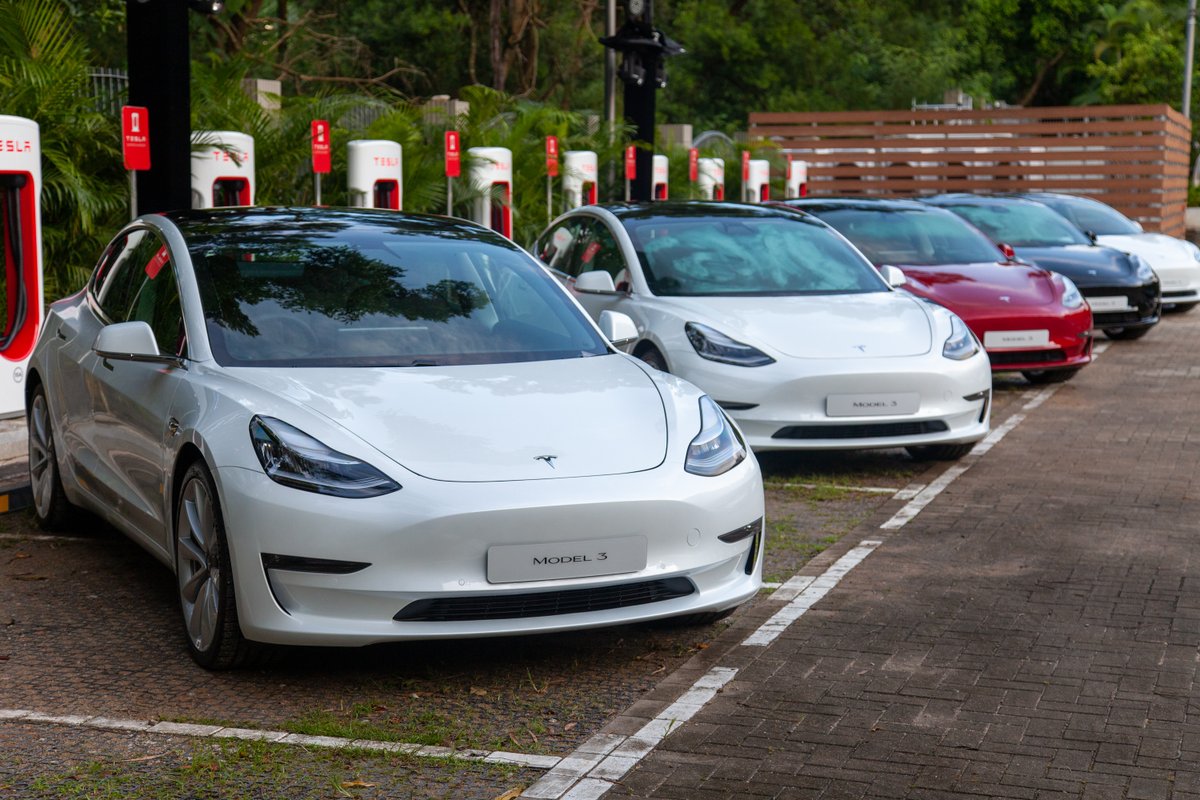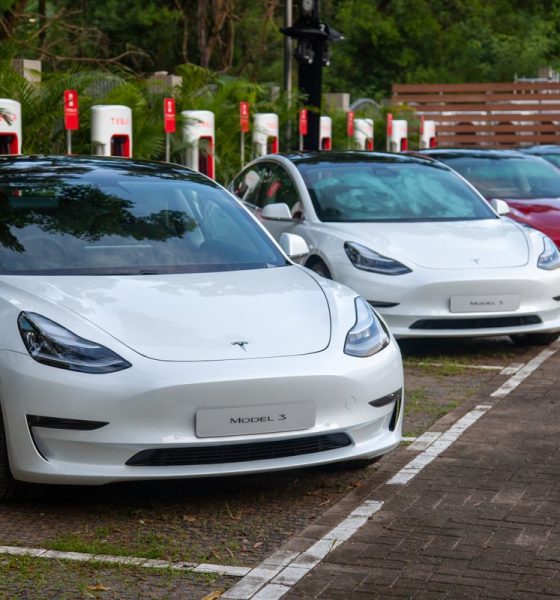

News
Tesla’s new Model 3 pricing in China is driving local competitors into a corner
Tesla’s recent price adjustments to the Model 3 in China seem to be putting pressure on the electric car maker’s domestic rivals. With the Made-in-China Model 3 Standard Range Plus now being cheaper than competitors from local brands, Tesla has raised the stakes in what seems to be a rush to capture the country’s re-emerging EV market.
China has long been the leader in electric car sales across the globe, but the country’s momentum was disrupted last year when the government slashed its EV subsidies. These headwinds were highlighted further when the pandemic hit this year, which put even more pressure on electric car makers. So notable was the cut in China’s EV sector that Europe has overtaken the country as the largest electric vehicle market this 2020.
That being said, China’s electric car segment seems poised for a comeback. As noted in a report from The Wall Street Journal, a lower base and a gradually recovering Chinese economy have resulted in rising electric car sales since July. Numerous companies have taken advantage of this renewed momentum, the most notable of which is American electric car maker Tesla, which operates a vehicle production plant in Shanghai.
The electric car maker has been in an aggressive push to lower its vehicle production costs in its Gigafactory Shanghai facility. Thanks to an increasingly localized supply chain, Tesla has been able to steadily lower the price of its Model 3 Standard Range Plus sedan, the company’s entry-level vehicle. The most notable of these price adjustments was arguably rolled out recently, which cut 8% of the vehicle’s cost.
Tesla was able to accomplish this thanks in part to the company’s strategy of using lithium-iron-phosphate (LFP) batteries for the Model 3 Standard Range Plus, which are cobalt-free and more affordable. With these price reductions, Tesla’s entry-level EV actually ended up being more affordable than some of its domestic rivals, particularly Xpeng Motors’ P7 sedan, which has been positioned as a Model 3 competitor.
Unfortunately for local carmakers, Tesla’s recent price adjustment is something that is not easily replicated. Xpeng, which is poised to be hit hard with the Model 3’s new pricing, announced that it would not be cutting the P7’s prices. According to the carmaker, cutting prices at this point would require earlier buyers to be compensated, which could weigh on the company. And it’s not just Xpeng, either. Other domestic carmakers like NIO and BYD are poised to feel the effects of Tesla’s aggressive pricing as well.
It should be noted that Tesla is already putting this much pressure on local EV makers in China with a premium, midsized vehicle. During Battery Day, the company confirmed that a $25,000 Tesla is on the way, and Musk later noted that the vehicle will be produced in China. Such an electric car, thanks to its even lower price point, could very well disrupt the market at a level that not even the Model 3 or Model Y could reach.

News
Tesla FSD fleet is nearing 7 billion total miles, including 2.5 billion city miles
As can be seen on Tesla’s official FSD webpage, vehicles equipped with the system have now navigated over 6.99 billion miles.

Tesla’s Full Self-Driving (Supervised) fleet is closing in on almost 7 billion total miles driven, as per data posted by the company on its official FSD webpage.
These figures hint at the massive scale of data fueling Tesla’s rapid FSD improvements, which have been quite notable as of late.
FSD mileage milestones
As can be seen on Tesla’s official FSD webpage, vehicles equipped with the system have now navigated over 6.99 billion miles. Tesla owner and avid FSD tester Whole Mars Catalog also shared a screenshot indicating that from the nearly 7 billion miles traveled by the FSD fleet, more than 2.5 billion miles were driven inside cities.
City miles are particularly valuable for complex urban scenarios like unprotected turns, pedestrian interactions, and traffic lights. This is also the difference-maker for FSD, as only complex solutions, such as Waymo’s self-driving taxis, operate similarly on inner-city streets. And even then, incidents such as the San Francisco blackouts have proven challenging for sensor-rich vehicles like Waymos.
Tesla’s data edge
Tesla has a number of advantages in the autonomous vehicle sector, one of which is the size of its fleet and the number of vehicles training FSD on real-world roads. Tesla’s nearly 7 billion FSD miles then allow the company to roll out updates that make its vehicles behave like they are being driven by experienced drivers, even if they are operating on their own.
So notable are Tesla’s improvements to FSD that NVIDIA Director of Robotics Jim Fan, after experiencing FSD v14, noted that the system is the first AI that passes what he described as a “Physical Turing Test.”
“Despite knowing exactly how robot learning works, I still find it magical watching the steering wheel turn by itself. First it feels surreal, next it becomes routine. Then, like the smartphone, taking it away actively hurts. This is how humanity gets rewired and glued to god-like technologies,” Fan wrote in a post on X.
News
Tesla starts showing how FSD will change lives in Europe
Local officials tested the system on narrow country roads and were impressed by FSD’s smooth, human-like driving, with some calling the service a game-changer for everyday life in areas that are far from urban centers.

Tesla has launched Europe’s first public shuttle service using Full Self-Driving (Supervised) in the rural Eifelkreis Bitburg-Prüm region of Germany, demonstrating how the technology can restore independence and mobility for people who struggle with limited transport options.
Local officials tested the system on narrow country roads and were impressed by FSD’s smooth, human-like driving, with some calling the service a game-changer for everyday life in areas that are far from urban centers.
Officials see real impact on rural residents
Arzfeld Mayor Johannes Kuhl and District Administrator Andreas Kruppert personally tested the Tesla shuttle service. This allowed them to see just how well FSD navigated winding lanes and rural roads confidently. Kruppert said, “Autonomous driving sounds like science fiction to many, but we simply see here that it works totally well in rural regions too.” Kuhl, for his part, also noted that FSD “feels like a very experienced driver.”
The pilot complements the area’s “Citizen Bus” program, which provides on-demand rides for elderly residents who can no longer drive themselves. Tesla Europe shared a video of a demonstration of the service, highlighting how FSD gives people their freedom back, even in places where public transport is not as prevalent.
What the Ministry for Economic Affairs and Transport says
Rhineland-Palatinate’s Minister Daniela Schmitt supported the project, praising the collaboration that made this “first of its kind in Europe” possible. As per the ministry, the rural rollout for the service shows FSD’s potential beyond major cities, and it delivers tangible benefits like grocery runs, doctor visits, and social connections for isolated residents.
“Reliable and flexible mobility is especially vital in rural areas. With the launch of a shuttle service using self-driving vehicles (FSD supervised) by Tesla in the Eifelkreis Bitburg-Prüm, an innovative pilot project is now getting underway that complements local community bus services. It is the first project of its kind in Europe.
“The result is a real gain for rural mobility: greater accessibility, more flexibility and tangible benefits for everyday life. A strong signal for innovation, cooperation and future-oriented mobility beyond urban centers,” the ministry wrote in a LinkedIn post.
News
Tesla China quietly posts Robotaxi-related job listing
Tesla China is currently seeking a Low Voltage Electrical Engineer to work on circuit board design for the company’s autonomous vehicles.

Tesla has posted a new job listing in Shanghai explicitly tied to its Robotaxi program, fueling speculation that the company is preparing to launch its dedicated autonomous ride-hailing service in China.
As noted in the listing, Tesla China is currently seeking a Low Voltage Electrical Engineer to work on circuit board design for the company’s autonomous vehicles.
Robotaxi-specific role
The listing, which was shared on social media platform X by industry watcher @tslaming, suggested that Tesla China is looking to fill the role urgently. The job listing itself specifically mentions that the person hired for the role will be working on the Low Voltage Hardware team, which would design the circuit boards that would serve as the nervous system of the Robotaxi.
Key tasks for the role, as indicated in the job listing, include collaboration with PCB layout, firmware, mechanical, program management, and validation teams, among other responsibilities. The role is based in Shanghai.
China Robotaxi launch
China represents a massive potential market for robotaxis, with its dense urban centers and supportive policies in select cities. Tesla has limited permission to roll out FSD in the country, though despite this, its vehicles have been hailed as among the best in the market when it comes to autonomous features. So far, at least, it appears that China supports Tesla’s FSD and Robotaxi rollout.
This was hinted at in November, when Tesla brought the Cybercab to the 8th China International Import Expo (CIIE) in Shanghai, marking the first time that the autonomous two-seater was brought to the Asia-Pacific region. The vehicle, despite not having a release date in China, received a significant amount of interest among the event’s attendees.








